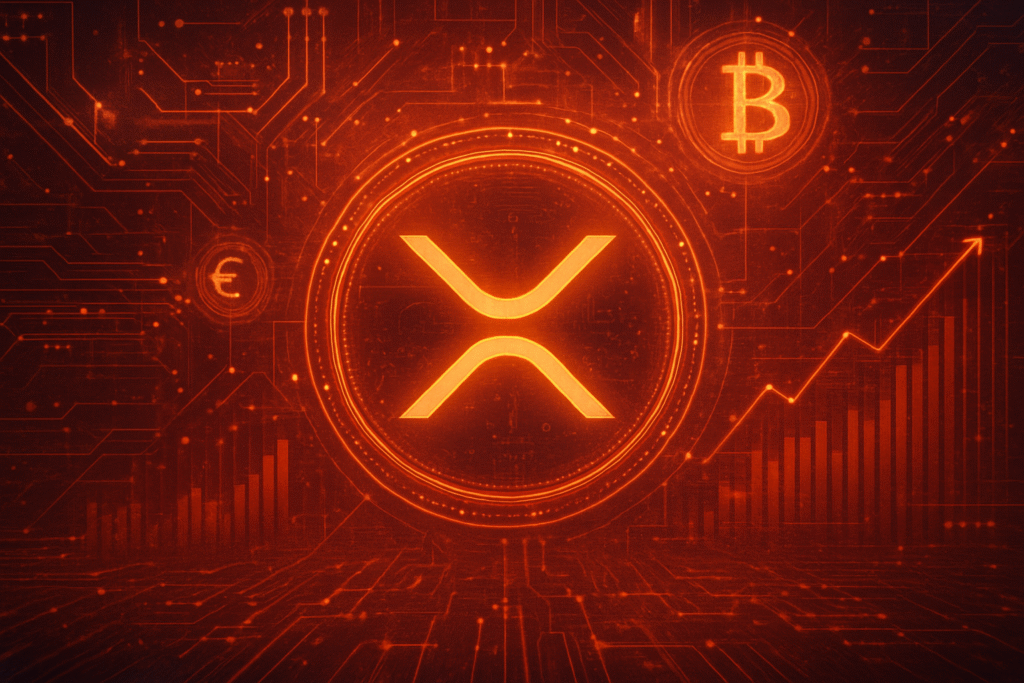
The cryptocurrency market is buzzing with the highly anticipated debut of several spot XRP Exchange-Traded Funds (ETFs), which have collectively surged towards an impressive $1 billion in assets under management (AUM) since their mid-November 2025 launch. This monumental inflow of capital, occurring within weeks of their introduction, marks a pivotal moment for the XRP ecosystem and the broader digital asset landscape, signaling a powerful surge in investor demand for XRP-backed investment products.
As of November 28, 2025, the combined AUM across the active spot XRP ETFs stands at a robust $801.7 million, with market analysts projecting a swift breach of the $1 billion threshold within their inaugural month of trading. The immediate market reaction has been overwhelmingly positive, characterized by significant trading volumes and a notable uptick in XRP's price, underscoring a newfound institutional confidence and mainstream acceptance for the digital asset. This strong debut is not merely a testament to XRP's resilience but also a clear indicator of the maturing crypto market's readiness for diverse, regulated investment vehicles beyond Bitcoin (BTC) and Ethereum (ETH).
Market Impact and Price Action
The debut of spot XRP ETFs in mid-November 2025 has created a dynamic and at times volatile market environment for XRP. While the initial euphoria led to a "buy the rumor, sell the news" phenomenon, the long-term implications for institutional integration appear robust. Immediately following the launch of key ETFs, including the Bitwise XRP ETF and Franklin Templeton's EZRP, XRP experienced an initial dip below the $2 mark, with some reports noting an over 7.6% decline shortly after the Bitwise launch, and an overall drop of over 18% from its pre-launch highs. This pattern mirrors the initial post-launch price corrections observed with Bitcoin (BTC) and Ethereum (ETH) spot ETFs.
Despite the initial retracement, the inflows into these new investment vehicles have been substantial. Canary Capital's (NYSE: CC) XRPC ETF has emerged as a frontrunner, attracting an impressive $331 million in net inflows, with the Bitwise XRP ETF following suit with $168 million. On their opening day, U.S.-listed spot XRP ETFs collectively pulled in nearly 80 million XRP tokens, rapidly accumulating $778 million in total assets under management. Overall, these spot XRP ETFs have attracted over $643.91 million in inflows, with an impressive 8-day inflow streak totaling over $620 million. This significant capital injection has propelled XRP's 24-hour trading volume, which jumped by 26% to $6.12 billion in the initial week of ETF trading, now stabilizing around $3.85 billion to $4.03 billion daily.
From a technical analysis perspective, XRP has demonstrated resilience, finding stabilization around the $2.05–$2.10 range after testing crucial support near $1.90. Analysts point to formations like a right-angled ascending broadening wedge and a descending wedge on daily charts, suggesting potential for upward momentum if these support levels hold. A critical resistance level is identified at $2.20; a confirmed breakout above this threshold could pave the way for moves towards $2.35–$2.45. The Relative Strength Index (RSI) consistently remaining above 50 further underscores resilient demand, though XRP continues to trade below its 50, 100, and 200 Exponential Moving Averages (EMAs), indicating a broader bearish trend that the short-term ETF-driven strength is working to counteract.
Comparing the XRP ETF debut to its predecessors, Bitcoin spot ETFs, launched in January 2024, saw an initial dip below $40,000 before a monumental surge to new record highs above $73,000 by March 2024. Ethereum spot ETFs, debuting in July 2024, attracted over $1 billion in first-day trading volume but saw relatively stagnant price action, suggesting much of the anticipation was already priced in. A key distinction for XRP ETFs is their expedited regulatory approval, facilitated by "general listing standards" and an "8(a) clause" fast-track process. This allowed altcoin ETFs to launch in weeks or months, a stark contrast to Bitcoin's decade-long regulatory battle. While all three experienced a "sell-the-news" effect, the rapid regulatory path for XRP indicates a potentially evolving and more favorable stance on certain altcoins within traditional finance.
Community and Ecosystem Response
The debut of spot XRP ETFs has ignited a vibrant, albeit complex, reaction across the crypto community and ecosystem. Social media platforms buzzed with activity, recording approximately 29,190 mentions and nearly 12.95 million engagements related to XRP, indicating widespread interest. While an initial "shock wave" of excitement swept through the "XRP Army," with many expressing a sentiment that "XRP is next in line with the big boys" after years of regulatory uncertainty, the overall sentiment leaned towards cautious optimism, as reflected by a Galaxy Score around 62. This tempered enthusiasm was partly due to an observed divergence between robust institutional inflows into the ETFs and a less dramatic, sometimes even negative, immediate price reaction for XRP, leading to discussions about potential whale-driven selling and a lack of uniform retail participation.
Crypto influencers and thought leaders largely echoed this mixed perspective, celebrating the long-term implications while acknowledging short-term volatilities. Ripple CEO Brad Garlinghouse, for instance, enthusiastically proclaimed, "It's (finally!) happening!" on social media, underscoring the significance of this milestone following Ripple's protracted legal battle with the U.S. Securities and Exchange Commission (SEC). Bloomberg Senior ETF Analyst Eric Balchunas had accurately anticipated strong initial performance for funds like Canary Capital's XRPC, which closed its first day with $58 million in trading volume, outperforming other crypto ETF debuts of the year. However, other analysts, such as Chad Steingraber, cautioned that sustained growth would be gradual, as financial advisors take time to recommend these new products. The consensus among experts is that while ETFs provide crucial access for institutional capital, they do not guarantee instant price explosions, rather enabling a steady, long-term flow.
The implications for the broader XRP ecosystem, including its nascent DeFi, NFT, and Web3 projects, are overwhelmingly positive. The increased institutional visibility and regulatory clarity provided by the ETFs are expected to shift XRP's role beyond its traditional payments niche, fostering its growth as a versatile investment and on-chain settlement asset. Calls for native staking on the XRP Ledger, alongside existing community-driven DeFi initiatives like Doppler Finance and the Flare network exploring yield programs for XRP, signal a move towards enhanced utility. Ripple's (NASDAQ: RPL) own strategic investments in infrastructure and the forthcoming integration of its stablecoin, RLUSD, are poised to bridge DeFi liquidity with traditional finance, particularly in critical global payment corridors. While direct, immediate impacts on NFT projects are still unfolding, the overall environment of institutional comfort and regulatory affirmation is creating a more fertile ground for innovation and expansion within Web3 projects leveraging the XRP Ledger, especially those focusing on specialized on-chain payment rails and the creator economy.
What's Next for Crypto
The strong debut of XRP ETFs ushers in a new era for the cryptocurrency market, carrying both immediate and profound long-term implications. In the short term, the market can anticipate continued price volatility for XRP, characterized by a "sell-the-news" dynamic that often follows significant launches. Despite this, the ETFs are already driving increased liquidity and trading volume, with Canary Capital's (NYSE: CC) XRPC ETF attracting $245 million on its first day alone and cumulative net inflows across various funds surpassing $644 million within eight trading days. This surge in institutional capital inflows, as financial advisors and institutions gain regulated access to XRP exposure, is expected to continue tightening the liquid supply of XRP as fund sponsors acquire coins for custody. However, short-term market sentiment may remain mixed, influenced by broader macroeconomic uncertainties and potential large-scale selling by "whales."
Looking ahead, the long-term implications are transformative. XRP ETFs are significantly enhancing XRP's integration with traditional finance, positioning it as a potentially foundational asset within diversified investment portfolios. This sustained institutional demand, coupled with a reduction in the circulating supply, could lead to substantial long-term price appreciation, with some analysts projecting annual inflows ranging from $7 billion to $10 billion. Crucially, the approval of XRP ETFs, following Ripple's landmark legal victory that clarified XRP's non-security status in secondary sales, sets a vital precedent for regulatory clarity in the crypto market. This could catalyze clearer rules for the broader digital asset sector and pave the way for ETFs based on other high-liquidity altcoins, expanding the overall utility of the XRP Ledger (XRPL) beyond mere speculation into areas like cross-border payments, stablecoins, and tokenized real-world assets (RWAs).
Several catalysts could further accelerate the adoption and influence of XRP ETFs. The August 2025 settlement between Ripple and the SEC was a monumental step, but further definitive federal frameworks for crypto would undoubtedly reduce uncertainty and encourage greater institutional participation. Ripple's (NASDAQ: RPL) ongoing expansion into institutional liquidity solutions, such as its acquisition of Hidden Road to form Ripple Prime, and strategic partnerships with global banks, will continue to reinforce confidence and drive demand. The sustained success and consistent inflows into the initial XRP ETFs will likely incentivize other major asset managers, including giants like BlackRock (NYSE: BLK), to launch their own XRP ETF products once regulatory conditions are fully settled. Furthermore, the continuous development and adoption of XRPL features, such as automated market makers (AMMs) and tools for issuing tokenized RWAs, will enhance XRP's fundamental value and appeal.
For projects within the crypto space, strategic considerations now revolve around regulatory compliance, robust liquidity, and clear real-world utility to attract institutional interest and potential ETF eligibility. For investors, it's crucial to weigh the benefits of regulated ETF access against direct XRP ownership, considering management fees, utility, and tax complexities. A long-term investment horizon is advisable, given the expected short-term volatility but strong long-term potential. Investors should also focus on diversification and risk management, while closely monitoring sustained ETF inflows and changes in XRP's circulating supply for insights into future price movements. Possible scenarios range from a highly bullish outcome, where consistent inflows lead to significant price surges and an altcoin ETF boom, to a more mixed or volatile trajectory with intermittent gains and corrections, or even a suppressed variant where price stagnation persists despite inflows due to ongoing regulatory hurdles or market manipulation.
Bottom Line
The robust debut of XRP ETFs marks a watershed moment for the cryptocurrency market, offering profound implications for both investors and the broader adoption of digital assets. The primary takeaway for crypto investors and enthusiasts is the significantly broadened access to XRP, allowing both retail and institutional players to gain exposure through regulated, familiar investment vehicles without the complexities of direct cryptocurrency management. The strong initial capital inflows, exemplified by Grayscale's (NASDAQ: GRSP) GXRP and Franklin Templeton's (NYSE: BEN) XRPZ collectively attracting nearly $130 million on their launch day, and Canary Capital's (NYSE: CC) XRPC drawing $245 million, underscore a powerful and undeniable demand for XRP-backed products. While short-term market optimism is tempered by initial "sell-the-news" volatility, the competitive fee structures and diversification opportunities presented by these ETFs are reshaping investment strategies.
Assessing the long-term significance, XRP ETFs represent a paradigm shift in institutional engagement with digital assets. They are effectively bridging the gap between speculative crypto markets and traditional finance, facilitating enhanced liquidity and potentially greater price stability for XRP as substantial capital inflows absorb tokens from the open market. Analysts project these ETFs could attract between $4 billion and $8 billion in their first year, with annual inflows potentially reaching $7 billion to $10 billion, positioning XRP as one of the most institutionally held altcoins globally. This regulatory validation, following XRP's landmark legal victory, contributes significantly to the maturation of the entire digital asset class and lays a foundation for sustained growth driven by XRP's real-world utility in cross-border payments, asset tokenization, and the ongoing development of the XRP Ledger.
Ultimately, this development accelerates crypto adoption by simplifying the on-ramp for traditional investors and fostering increased mainstream acceptance through regulatory endorsement. It enables accelerated institutional integration, leading to a potential tiering within the crypto market where assets with ETF support gain a considerable advantage in attracting capital. For investors, vigilance is key: continuously monitor ETF inflows and Assets Under Management (AUM) as critical indicators of demand. Track trading volumes and liquidity of both the ETFs and underlying spot XRP pairs, alongside changes in XRP's circulating supply, which could signal scarcity. Closely observe XRP's price action and technical indicators for support and resistance levels, and keep an eye on futures Open Interest for broader market sentiment. Furthermore, the evolving regulatory landscape and the continued growth of Ripple's ecosystem and on-ledger utility—from cross-border payments to stablecoin activity—will be crucial metrics to monitor for XRP's long-term trajectory.
This article is for informational purposes only and does not constitute financial or investment advice. Cryptocurrency investments carry significant risk.





